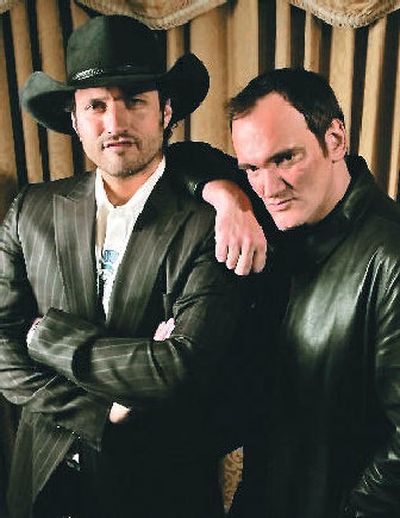A frightening pair

In an age of pristine digital images and violence watered down to the point where 13-year-olds can see it without a parent, old pals Quentin Tarantino and Robert Rodriguez present a different night out at the movies:
Tattered images scratched and torn from the constant grind of projectors in seedy theaters.
Nauseating gore from a plague of putrid zombies.
Savage assaults by a psycho killer in a muscle car.
A hot chick with a machine gun attached to the stump of her recently severed leg.
Entire reels missing from the films.
“Grindhouse,” opening today, is a three-hour double feature punctuated by corny old concession ads and fake trailers for violent exploitation movies that look even more rabid and bloody than the real ones Tarantino and Rodriguez directed.
“Pulp Fiction” creator Tarantino and “Sin City” director Rodriguez deliberately inserted scratches and little hiccups where frames of film went missing to simulate the wear-and-tear of celluloid that has seen better days.
A throwback to the twin bills at drive-ins and rundown theaters – called “grindhouses” – that helped hook the filmmakers on cinema as kids, “Grindhouse” had its start from a visit Rodriguez paid to Tarantino’s house.
Rodriguez noticed a double-feature poster for Roger Corman’s low-budget crime thriller “Rock All Night” and another old B-movie, “Dragstrip Girl.” He and told Tarantino that he had the same poster at home.
That revived an idea Rodriguez had long had about doing a double-bill.
For “Grindhouse,” Rodriguez contributed the zombie flick “Planet Terror,” with a cast including Bruce Willis, Freddy Rodriguez, Marley Shelton, Michael Biehn and Rose McGowan as the woman who ends up with a machine-gun leg.
Tarantino cast Kurt Russell as a maniac driver in his “Death Proof,” about an ex-stuntman who uses his beefed-up car to terrorize women, including McGowan (again), Rosario Dawson, Sydney Tamiia Poitier and stuntwoman Zoe Bell.
The directors sat down for a discussion about their energy, unpredictability and just plain nasty fun:
Q: What adjectives leap to mind when you think of grindhouse films?
Rodriguez: Sensationalism.
Tarantino: Definitely. People go, “What was it about these movies that you saw when you were a kid?” I go, “You know, there was an aspect about them, the posters, the newspaper ads, the TV spots.” They were just so sensation-filled. It was almost like a light bulb and a moth. I just found myself drawn to it, fascinated by it. They were always that forbidden fruit.
There was something naughty about these. They actually existed outside the rules of Hollywood. If there was a coloring book, Hollywood kept it inside the lines. You never knew where that crayon would go with an exploitation film, a grindhouse movie.
Rodriguez: You felt a little dirty afterward, a little scummy. … You never know how far the filmmaker’s going to go, because they’re not schooled. They’re not trained. They might do something that’s completely wrong.
Q: Robert, when did that iconic image of the woman with a machine-gun leg hit you?
Rodriguez: I needed some sensational central image to help get across in a trailer and a poster. People have seen zombies. It needs some other hook. I’ve got the girl with no leg, then suddenly, I just pictured her firing a machine-gun leg. I thought, “Oh my God, that would be such a sexy, cool image,” especially if it’s done really low-budget, where it’s not a “Terminator” fancy leg. It’s just a stump with an Ace bandage and a gun jammed in it.
Q: Quentin, where’d the idea for “Death Proof” come from?
Tarantino: I just got through rewatching and doing my own cinematic research study of the slasher films of the late ‘70s, early ‘80s. So I was kind of all flush with that, so I thought, “OK, let me do a slasher film.” Maybe I should attack the slasher film the way I attacked heist films in “Reservoir Dogs,” which is just my own weird, crazy, idiosyncratic, cockamamie version of it.
I remembered a conversation I had 10 years earlier. I was talking about getting a car. I was driving this Geo Metro, which is like driving a big red Coke can, about as safe. I was talking to somebody involved in the movies and they said, “Buy any car, give it to a stunt team, pay them $10,000, and it’ll be death proof. Have them death-proof it.”
When it came time to do this, all of a sudden it hit me: That’s what the guy uses. He’s an ex-stuntman. He has a stunt car, and he can crash into any group of girls that’s he’s been stalking. He doesn’t have to chase them down with a knife and kill them one by one. He can take them all, all four souls at the exact same time. He can get into any crash he wants, and he’ll live through it.
Q: The idea of a double bill of genre pictures and trailers sounds like what Quentin does at home for friends or at film festivals.
Rodriguez: He’s got a whole retrospective of grindhouse. He’s programmed everything from trailers to movies. You go to his house, he’s got a double feature with the right trailers that he’s hand-picked, and when he does his festivals. I’ve been seeing his double, triple features our whole friendship, and it sunk in.
Tarantino: The way other people invite people over to their house, and they’d have a big dinner for them, that’s their way of entertaining. My way of entertaining is to show them movies and create this little show for the night. There is an aspect that I am a frustrated theater manager.